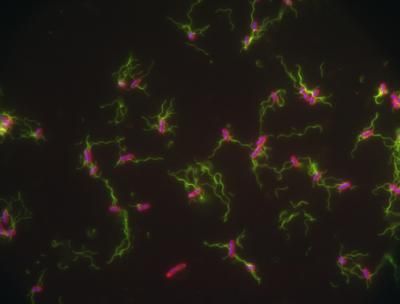Illinois researchers use pyrosequencing to study canine intestinal bacteria
Advertisement
A dog's indiscriminate taste is not always a positive trait. In fact, it often leads to gastrointestinal infections and consequent ailments such as diarrhea and vomiting that come from eating spoiled food. Others develop gastrointestinal diseases such as inflammatory bowel diseases that are not directly attributed to the diet, but are influenced by intestinal bacteria.
Researchers at the University of Illinois are making strides in devising dietary interventions to combat these infections through advanced DNA pyrosequencing technology. This new method of DNA sequencing has helped researchers uncover the phylogeny or "who's there" in a healthy dog's gut. Their goal was to obtain a standard that could be used as a comparison to diseased states in the future.
"It's a first step toward making progress in our understanding of how diet affects gastrointestinal infections," said Kelly Swanson, U of I associate professor of animal science. "Dogs do not rely heavily on microbial fermentation as it pertains to energy requirements, but a balanced and stable microbiota is critical for maintaining gastrointestinal health."
Up until now scientists could only culture a small percentage of the bacteria in a dog's gut and due to technological limitations, they couldn't determine the complete phylogeny. More than 80,000 DNA sequences were evaluated in the first study to reveal that the highest number of bacteria present in the gut were Firmicutes and Bacteriodetes. Fusobacteria, while not as common, were also among the highest number of bacteria found.
"Often we don't know if an altered bacterial community is the cause of disease or the effect of disease," he said. "We also don't know if it's one species or multiple species working together to create problems for the dog's intestinal health."
In a follow-up study, using approximately one million DNA sequences, their team identified the metabolic pathways that exist in intestinal bacteria of healthy animals including nutrient metabolism, virulence, and stress response, Swanson said. They also compared the phylogeny of a dog's intestine to that of humans, mice and chickens to determine similarities and differences between species.
Swanson and his teammates are interested in continuing to learn how dietary intervention, pharmaceuticals and age affect microbial populations. In addition, most pet dogs in developed countries are now treated as family, with many not only living in the home, but also eating, sleeping and playing with their owners. This close proximity has relevance in regards to zoonotic disease and the direct link between human and dog illness.
Original publication: Ingmar Middelbos, Brittany Vester Boler, Ani Qu, Bryan White, George Fahey and Swanson; "Phylogenetic characterization of fecal microbial communities of dogs fed diets with or without supplemental dietary fiber using 454 pyrosequencing"; PLoS ONE 2010.




























































